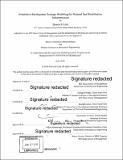| dc.contributor.advisor | Georgia Perakis and Saurabh Amin. | en_US |
| dc.contributor.author | Link, Steven B. | en_US |
| dc.contributor.other | Sloan School of Management. | en_US |
| dc.contributor.other | Massachusetts Institute of Technology. Department of Mechanical Engineering. | en_US |
| dc.contributor.other | Leaders for Global Operations Program. | en_US |
| dc.date.accessioned | 2019-11-12T17:37:08Z | |
| dc.date.available | 2019-11-12T17:37:08Z | |
| dc.date.copyright | 2018 | en_US |
| dc.date.issued | 2018 | en_US |
| dc.date.issued | 2018 | en_US |
| dc.identifier.uri | https://hdl.handle.net/1721.1/122832 | |
| dc.description | Thesis: M.B.A., Massachusetts Institute of Technology, Sloan School of Management, in conjunction with the Leaders for Global Operations Program at MIT, 2018 | en_US |
| dc.description | Thesis: S.M., Massachusetts Institute of Technology, Department of Mechanical Engineering, in conjunction with the Leaders for Global Operations Program at MIT, 2018 | en_US |
| dc.description | Cataloged from PDF version of thesis. | en_US |
| dc.description | Includes bibliographical references (pages 61-64). | en_US |
| dc.description.abstract | The Pacific Gas and Electric Company (PG&E) operates and maintains 48,000 miles of natural gas pipeline, serving over 4.3 million customer accounts. Along with water, electric power, and transportation services, these lifelines serve critical functions throughout multiple communities. Considering PG&E provides services in both densely populated and seismically active areas, the organization has invested extensively in modeling technology to help estimate resource needs and develop resiliency plans in the event of an earthquake. This thesis aimed to develop a damage prediction model to improve emergency response time and restoration efficiency. The machine-learning based model built upon currently used predictive algorithms, while adding features necessary to account for distribution branch lines and above-ground meter sets. Research and analysis showed factors beyond ground-motion prediction equations could be used to estimate pipeline damage and were consequently included. | en_US |
| dc.description.abstract | Furthermore, the model incorporated real-time data acquired throughout repair and restoration efforts in order to improve the predictive performance. Historical incidents were examined in the data aggregation phase in order to develop the training set. For this paper, damage was defined as the number of leaks predicted in a given plat, as defined by PG&E's mapping services. Leaks were categorized in three separate bins, ranging from 0 leaks, 1 to 5 leaks, and 6 or greater leaks. Multiple classification algorithms were chosen and evaluated against a custom scoring metric designed to discriminate and penalize false negatives. The best results were achieved using a series of five logistic regression algorithms, executed at 2, 4, 8, 12 and 24 hours following event occurrence. Results were designed to accompany currently used seismic hazard reports in a ranked table, displaying areas with the highest to lowest probability of experiencing damage. | en_US |
| dc.description.abstract | An additional web application was designed to query specific plats for prediction results. | en_US |
| dc.description.statementofresponsibility | by Steven B. Link. | en_US |
| dc.format.extent | 64 pages | en_US |
| dc.language.iso | eng | en_US |
| dc.publisher | Massachusetts Institute of Technology | en_US |
| dc.rights | MIT theses are protected by copyright. They may be viewed, downloaded, or printed from this source but further reproduction or distribution in any format is prohibited without written permission. | en_US |
| dc.rights.uri | http://dspace.mit.edu/handle/1721.1/7582 | en_US |
| dc.subject | Sloan School of Management. | en_US |
| dc.subject | Mechanical Engineering. | en_US |
| dc.subject | Leaders for Global Operations Program. | en_US |
| dc.title | Predictive earthquake damage modeling for natural gas distribution infrastructure | en_US |
| dc.type | Thesis | en_US |
| dc.description.degree | M.B.A. | en_US |
| dc.description.degree | S.M. | en_US |
| dc.contributor.department | Sloan School of Management | en_US |
| dc.contributor.department | Massachusetts Institute of Technology. Department of Mechanical Engineering | en_US |
| dc.contributor.department | Leaders for Global Operations Program | en_US |
| dc.identifier.oclc | 1126276969 | en_US |
| dc.description.collection | M.B.A. Massachusetts Institute of Technology, Sloan School of Management | en_US |
| dc.description.collection | S.M. Massachusetts Institute of Technology, Department of Mechanical Engineering | en_US |
| dspace.imported | 2019-11-12T17:37:07Z | en_US |
| mit.thesis.degree | Master | en_US |
| mit.thesis.department | Sloan | en_US |
| mit.thesis.department | MechE | en_US |
